2013 FORD FIESTA child seat
[x] Cancel search: child seatPage 42 of 341
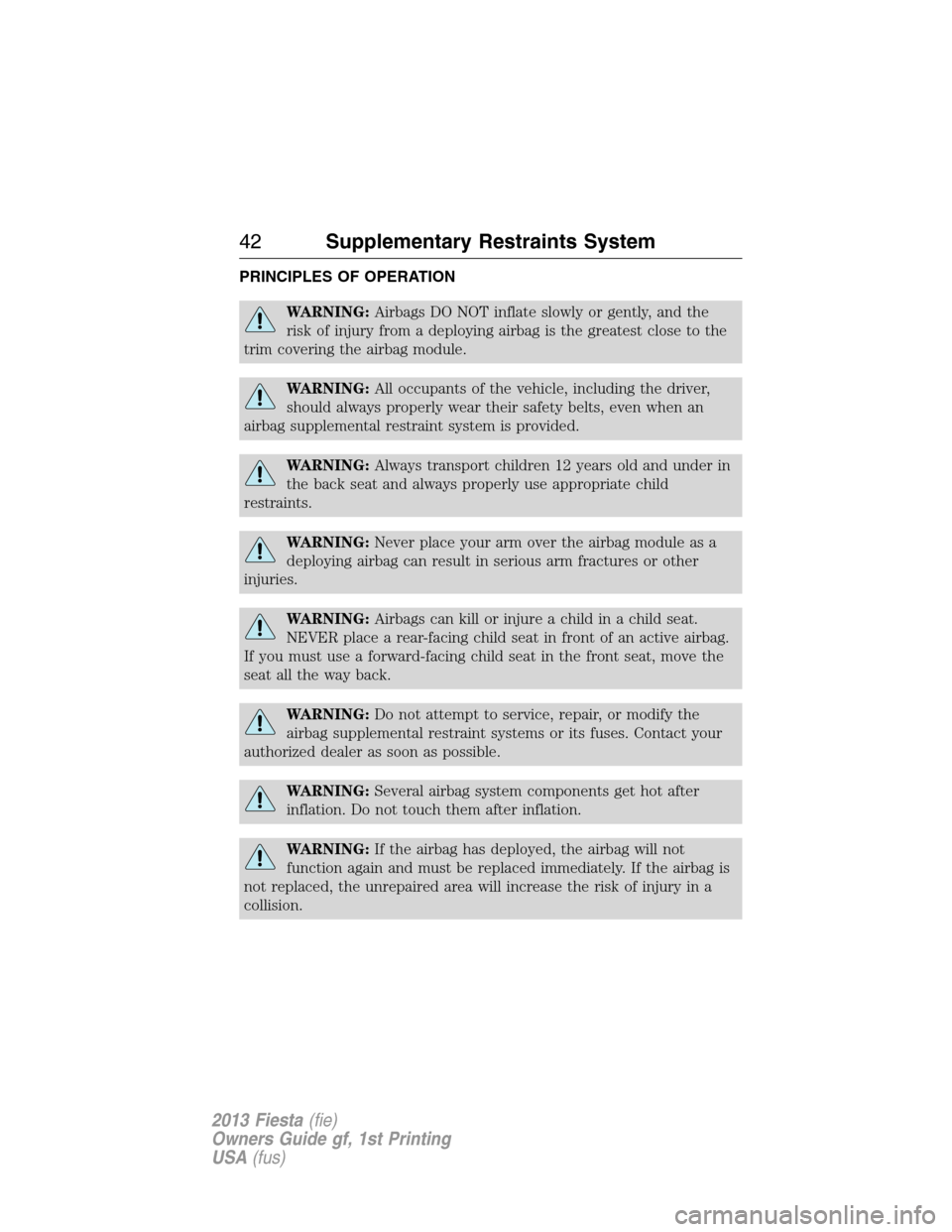
PRINCIPLES OF OPERATION
WARNING:Airbags DO NOT inflate slowly or gently, and the
risk of injury from a deploying airbag is the greatest close to the
trim covering the airbag module.
WARNING:All occupants of the vehicle, including the driver,
should always properly wear their safety belts, even when an
airbag supplemental restraint system is provided.
WARNING:Always transport children 12 years old and under in
the back seat and always properly use appropriate child
restraints.
WARNING:Never place your arm over the airbag module as a
deploying airbag can result in serious arm fractures or other
injuries.
WARNING:Airbags can kill or injure a child in a child seat.
NEVER place a rear-facing child seat in front of an active airbag.
If you must use a forward-facing child seat in the front seat, move the
seat all the way back.
WARNING:Do not attempt to service, repair, or modify the
airbag supplemental restraint systems or its fuses. Contact your
authorized dealer as soon as possible.
WARNING:Several airbag system components get hot after
inflation. Do not touch them after inflation.
WARNING:If the airbag has deployed, the airbag will not
function again and must be replaced immediately. If the airbag is
not replaced, the unrepaired area will increase the risk of injury in a
collision.
42Supplementary Restraints System
2013 Fiesta(fie)
Owners Guide gf, 1st Printing
USA(fus)
Page 44 of 341
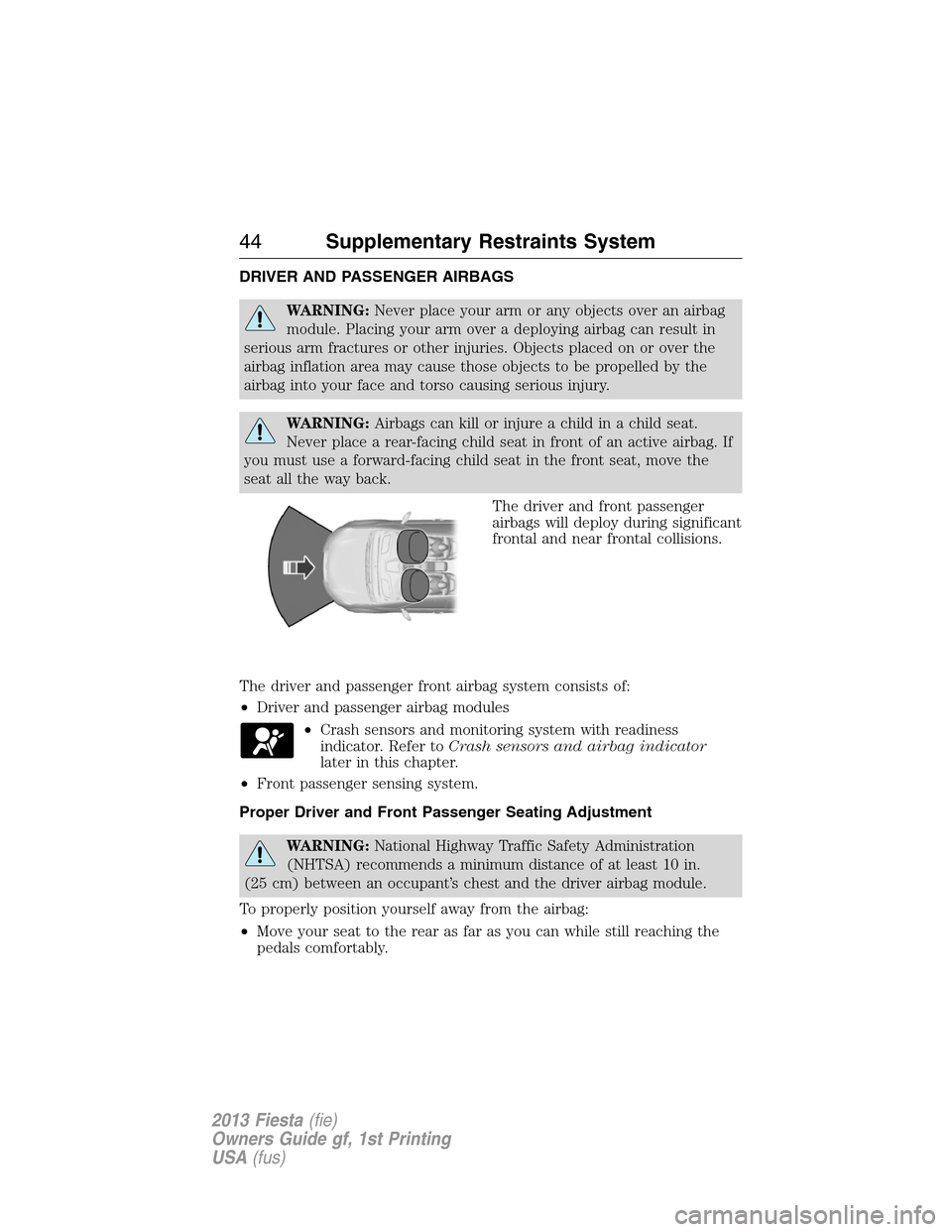
DRIVER AND PASSENGER AIRBAGS
WARNING:Never place your arm or any objects over an airbag
module. Placing your arm over a deploying airbag can result in
serious arm fractures or other injuries. Objects placed on or over the
airbag inflation area may cause those objects to be propelled by the
airbag into your face and torso causing serious injury.
WARNING:Airbags can kill or injure a child in a child seat.
Never place a rear-facing child seat in front of an active airbag. If
you must use a forward-facing child seat in the front seat, move the
seat all the way back.
The driver and front passenger
airbags will deploy during significant
frontal and near frontal collisions.
The driver and passenger front airbag system consists of:
•Driver and passenger airbag modules
•Crash sensors and monitoring system with readiness
indicator. Refer toCrash sensors and airbag indicator
later in this chapter.
•Front passenger sensing system.
Proper Driver and Front Passenger Seating Adjustment
WARNING:National Highway Traffic Safety Administration
(NHTSA) recommends a minimum distance of at least 10 in.
(25 cm) between an occupant’s chest and the driver airbag module.
To properly position yourself away from the airbag:
•Move your seat to the rear as far as you can while still reaching the
pedals comfortably.
44Supplementary Restraints System
2013 Fiesta(fie)
Owners Guide gf, 1st Printing
USA(fus)
Page 45 of 341
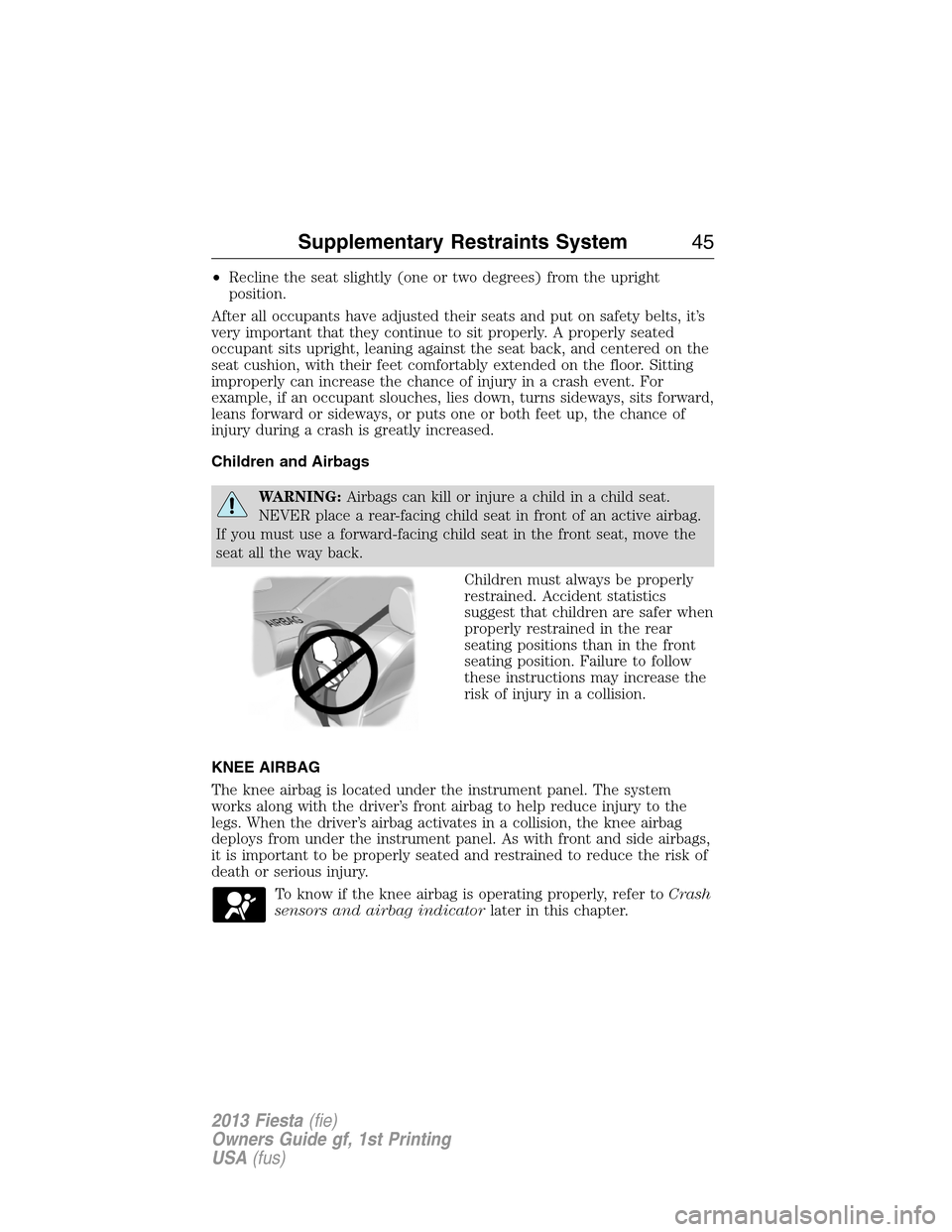
•Recline the seat slightly (one or two degrees) from the upright
position.
After all occupants have adjusted their seats and put on safety belts, it’s
very important that they continue to sit properly. A properly seated
occupant sits upright, leaning against the seat back, and centered on the
seat cushion, with their feet comfortably extended on the floor. Sitting
improperly can increase the chance of injury in a crash event. For
example, if an occupant slouches, lies down, turns sideways, sits forward,
leans forward or sideways, or puts one or both feet up, the chance of
injury during a crash is greatly increased.
Children and Airbags
WARNING:Airbags can kill or injure a child in a child seat.
NEVER place a rear-facing child seat in front of an active airbag.
If you must use a forward-facing child seat in the front seat, move the
seat all the way back.
Children must always be properly
restrained. Accident statistics
suggest that children are safer when
properly restrained in the rear
seating positions than in the front
seating position. Failure to follow
these instructions may increase the
risk of injury in a collision.
KNEE AIRBAG
The knee airbag is located under the instrument panel. The system
works along with the driver’s front airbag to help reduce injury to the
legs. When the driver’s airbag activates in a collision, the knee airbag
deploys from under the instrument panel. As with front and side airbags,
it is important to be properly seated and restrained to reduce the risk of
death or serious injury.
To know if the knee airbag is operating properly, refer toCrash
sensors and airbag indicatorlater in this chapter.
Supplementary Restraints System45
2013 Fiesta(fie)
Owners Guide gf, 1st Printing
USA(fus)
Page 46 of 341
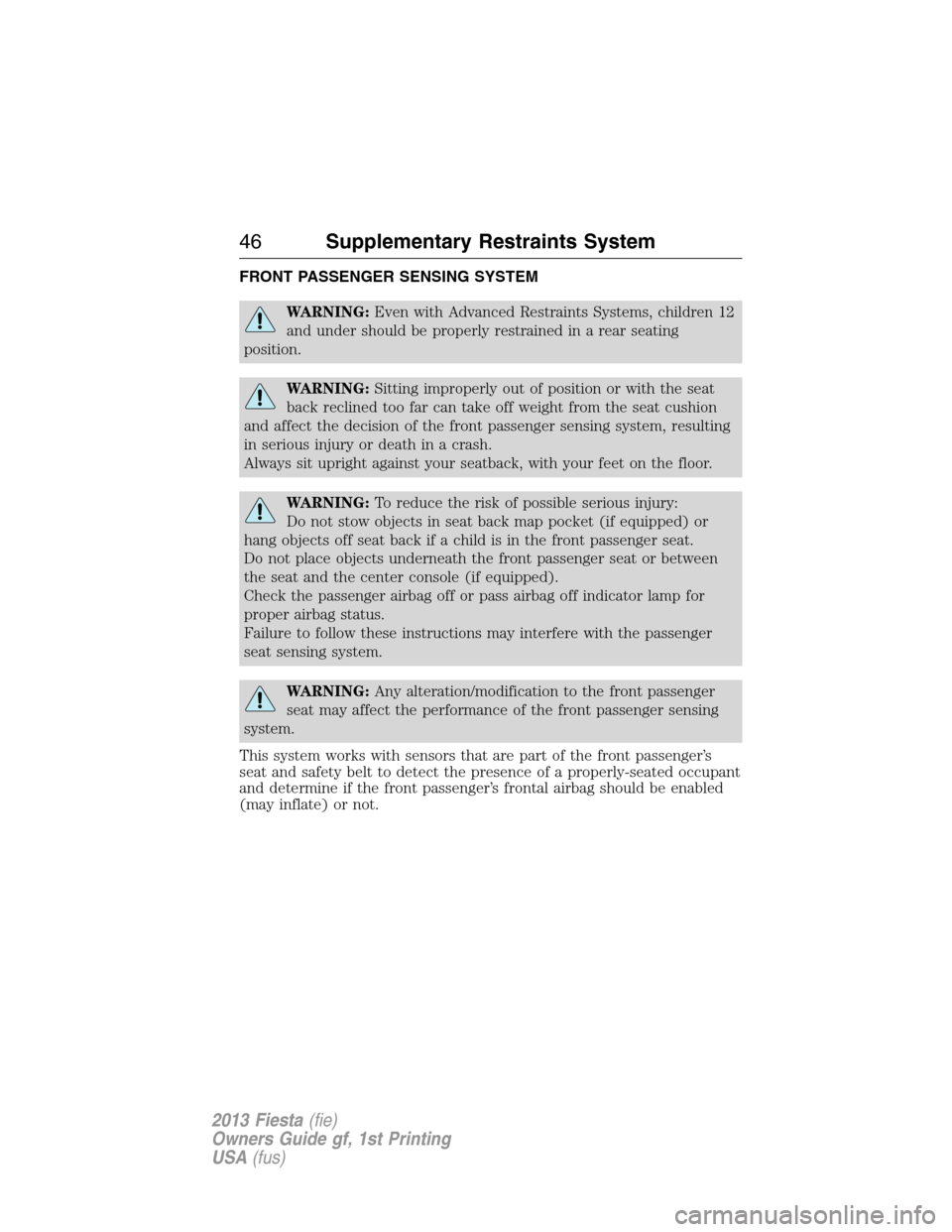
FRONT PASSENGER SENSING SYSTEM
WARNING:Even with Advanced Restraints Systems, children 12
and under should be properly restrained in a rear seating
position.
WARNING:Sitting improperly out of position or with the seat
back reclined too far can take off weight from the seat cushion
and affect the decision of the front passenger sensing system, resulting
in serious injury or death in a crash.
Always sit upright against your seatback, with your feet on the floor.
WARNING:To reduce the risk of possible serious injury:
Do not stow objects in seat back map pocket (if equipped) or
hang objects off seat back if a child is in the front passenger seat.
Do not place objects underneath the front passenger seat or between
the seat and the center console (if equipped).
Check the passenger airbag off or pass airbag off indicator lamp for
proper airbag status.
Failure to follow these instructions may interfere with the passenger
seat sensing system.
WARNING:Any alteration/modification to the front passenger
seat may affect the performance of the front passenger sensing
system.
This system works with sensors that are part of the front passenger’s
seat and safety belt to detect the presence of a properly-seated occupant
and determine if the front passenger’s frontal airbag should be enabled
(may inflate) or not.
46Supplementary Restraints System
2013 Fiesta(fie)
Owners Guide gf, 1st Printing
USA(fus)
Page 47 of 341
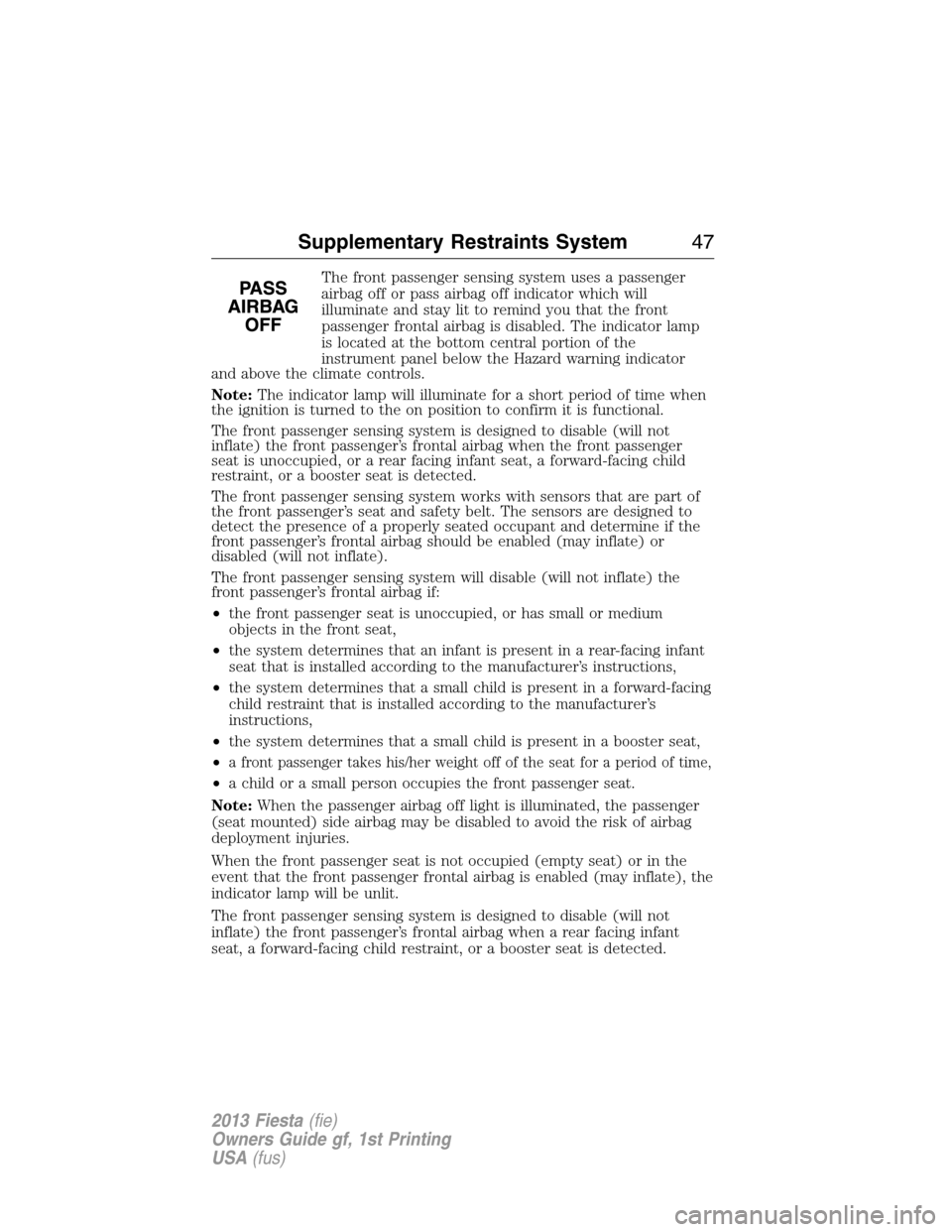
The front passenger sensing system uses a passenger
airbag off or pass airbag off indicator which will
illuminate and stay lit to remind you that the front
passenger frontal airbag is disabled. The indicator lamp
is located at the bottom central portion of the
instrument panel below the Hazard warning indicator
and above the climate controls.
Note:The indicator lamp will illuminate for a short period of time when
the ignition is turned to the on position to confirm it is functional.
The front passenger sensing system is designed to disable (will not
inflate) the front passenger’s frontal airbag when the front passenger
seat is unoccupied, or a rear facing infant seat, a forward-facing child
restraint, or a booster seat is detected.
The front passenger sensing system works with sensors that are part of
the front passenger’s seat and safety belt. The sensors are designed to
detect the presence of a properly seated occupant and determine if the
front passenger’s frontal airbag should be enabled (may inflate) or
disabled (will not inflate).
The front passenger sensing system will disable (will not inflate) the
front passenger’s frontal airbag if:
•the front passenger seat is unoccupied, or has small or medium
objects in the front seat,
•the system determines that an infant is present in a rear-facing infant
seat that is installed according to the manufacturer’s instructions,
•the system determines that a small child is present in a forward-facing
child restraint that is installed according to the manufacturer’s
instructions,
•the system determines that a small child is present in a booster seat,
•
a front passenger takes his/her weight off of the seat for a period of time,
•a child or a small person occupies the front passenger seat.
Note:When the passenger airbag off light is illuminated, the passenger
(seat mounted) side airbag may be disabled to avoid the risk of airbag
deployment injuries.
When the front passenger seat is not occupied (empty seat) or in the
event that the front passenger frontal airbag is enabled (may inflate), the
indicator lamp will be unlit.
The front passenger sensing system is designed to disable (will not
inflate) the front passenger’s frontal airbag when a rear facing infant
seat, a forward-facing child restraint, or a booster seat is detected.
Supplementary Restraints System47
2013 Fiesta(fie)
Owners Guide gf, 1st Printing
USA(fus)
Page 48 of 341
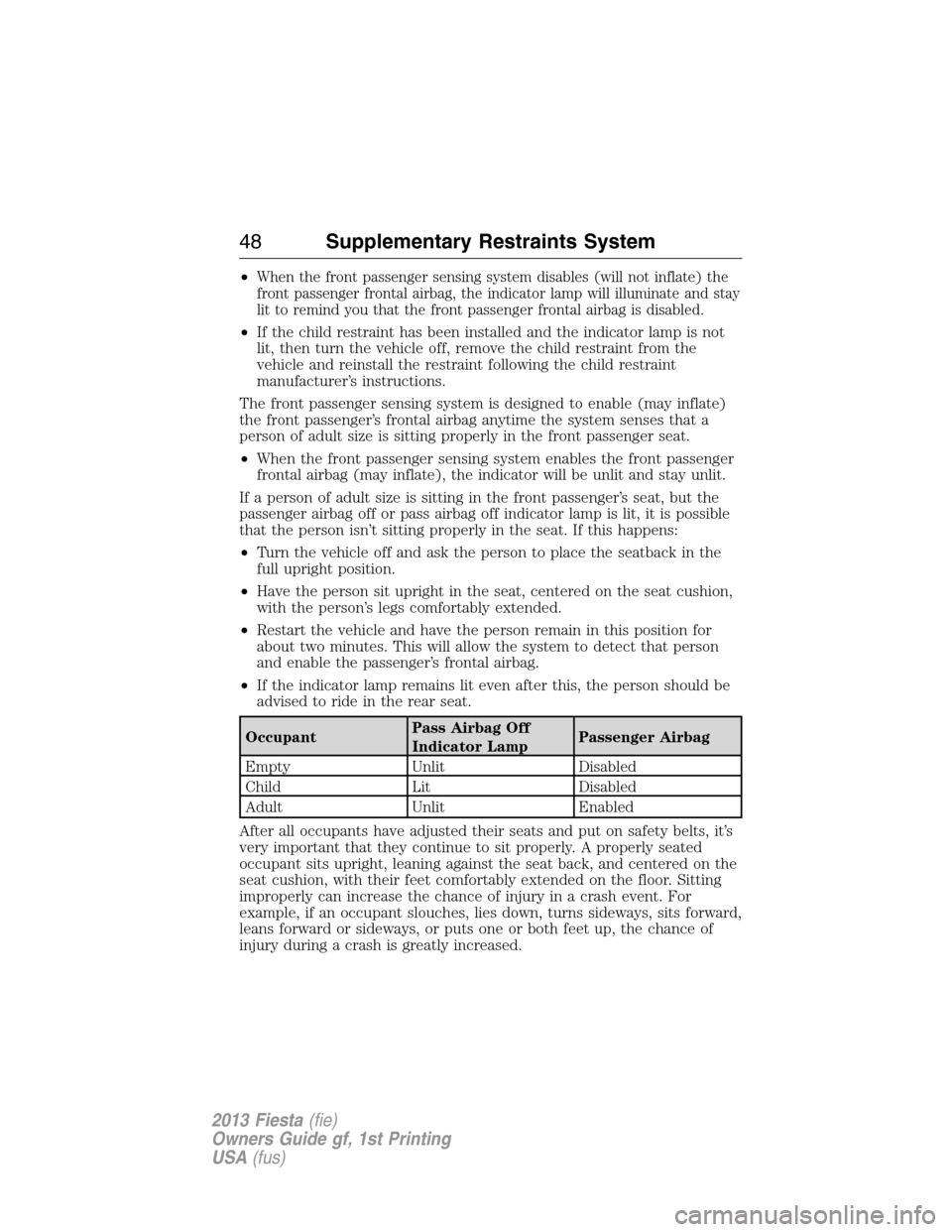
•When the front passenger sensing system disables (will not inflate) the
front passenger frontal airbag, the indicator lamp will illuminate and stay
lit to remind you that the front passenger frontal airbag is disabled.
•If the child restraint has been installed and the indicator lamp is not
lit, then turn the vehicle off, remove the child restraint from the
vehicle and reinstall the restraint following the child restraint
manufacturer’s instructions.
The front passenger sensing system is designed to enable (may inflate)
the front passenger’s frontal airbag anytime the system senses that a
person of adult size is sitting properly in the front passenger seat.
•When the front passenger sensing system enables the front passenger
frontal airbag (may inflate), the indicator will be unlit and stay unlit.
If a person of adult size is sitting in the front passenger’s seat, but the
passenger airbag off or pass airbag off indicator lamp is lit, it is possible
that the person isn’t sitting properly in the seat. If this happens:
•Turn the vehicle off and ask the person to place the seatback in the
full upright position.
•Have the person sit upright in the seat, centered on the seat cushion,
with the person’s legs comfortably extended.
•Restart the vehicle and have the person remain in this position for
about two minutes. This will allow the system to detect that person
and enable the passenger’s frontal airbag.
•If the indicator lamp remains lit even after this, the person should be
advised to ride in the rear seat.
OccupantPass Airbag Off
Indicator LampPassenger Airbag
Empty Unlit Disabled
Child Lit Disabled
Adult Unlit Enabled
After all occupants have adjusted their seats and put on safety belts, it’s
very important that they continue to sit properly. A properly seated
occupant sits upright, leaning against the seat back, and centered on the
seat cushion, with their feet comfortably extended on the floor. Sitting
improperly can increase the chance of injury in a crash event. For
example, if an occupant slouches, lies down, turns sideways, sits forward,
leans forward or sideways, or puts one or both feet up, the chance of
injury during a crash is greatly increased.
48Supplementary Restraints System
2013 Fiesta(fie)
Owners Guide gf, 1st Printing
USA(fus)
Page 53 of 341
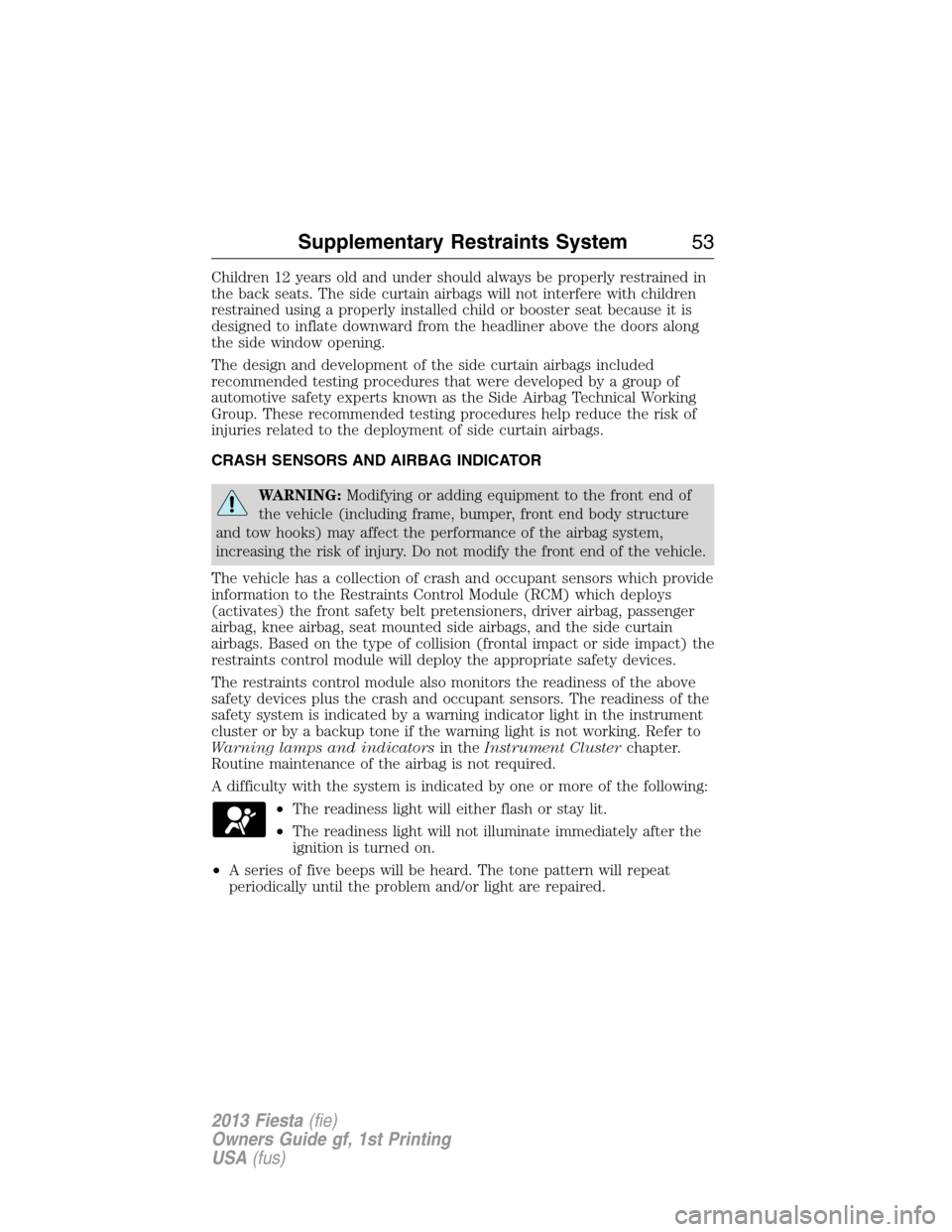
Children 12 years old and under should always be properly restrained in
the back seats. The side curtain airbags will not interfere with children
restrained using a properly installed child or booster seat because it is
designed to inflate downward from the headliner above the doors along
the side window opening.
The design and development of the side curtain airbags included
recommended testing procedures that were developed by a group of
automotive safety experts known as the Side Airbag Technical Working
Group. These recommended testing procedures help reduce the risk of
injuries related to the deployment of side curtain airbags.
CRASH SENSORS AND AIRBAG INDICATOR
WARNING:Modifying or adding equipment to the front end of
the vehicle (including frame, bumper, front end body structure
and tow hooks) may affect the performance of the airbag system,
increasing the risk of injury. Do not modify the front end of the vehicle.
The vehicle has a collection of crash and occupant sensors which provide
information to the Restraints Control Module (RCM) which deploys
(activates) the front safety belt pretensioners, driver airbag, passenger
airbag, knee airbag, seat mounted side airbags, and the side curtain
airbags. Based on the type of collision (frontal impact or side impact) the
restraints control module will deploy the appropriate safety devices.
The restraints control module also monitors the readiness of the above
safety devices plus the crash and occupant sensors. The readiness of the
safety system is indicated by a warning indicator light in the instrument
cluster or by a backup tone if the warning light is not working. Refer to
Warning lamps and indicatorsin theInstrument Clusterchapter.
Routine maintenance of the airbag is not required.
A difficulty with the system is indicated by one or more of the following:
•The readiness light will either flash or stay lit.
•The readiness light will not illuminate immediately after the
ignition is turned on.
•A series of five beeps will be heard. The tone pattern will repeat
periodically until the problem and/or light are repaired.
Supplementary Restraints System53
2013 Fiesta(fie)
Owners Guide gf, 1st Printing
USA(fus)
Page 336 of 341
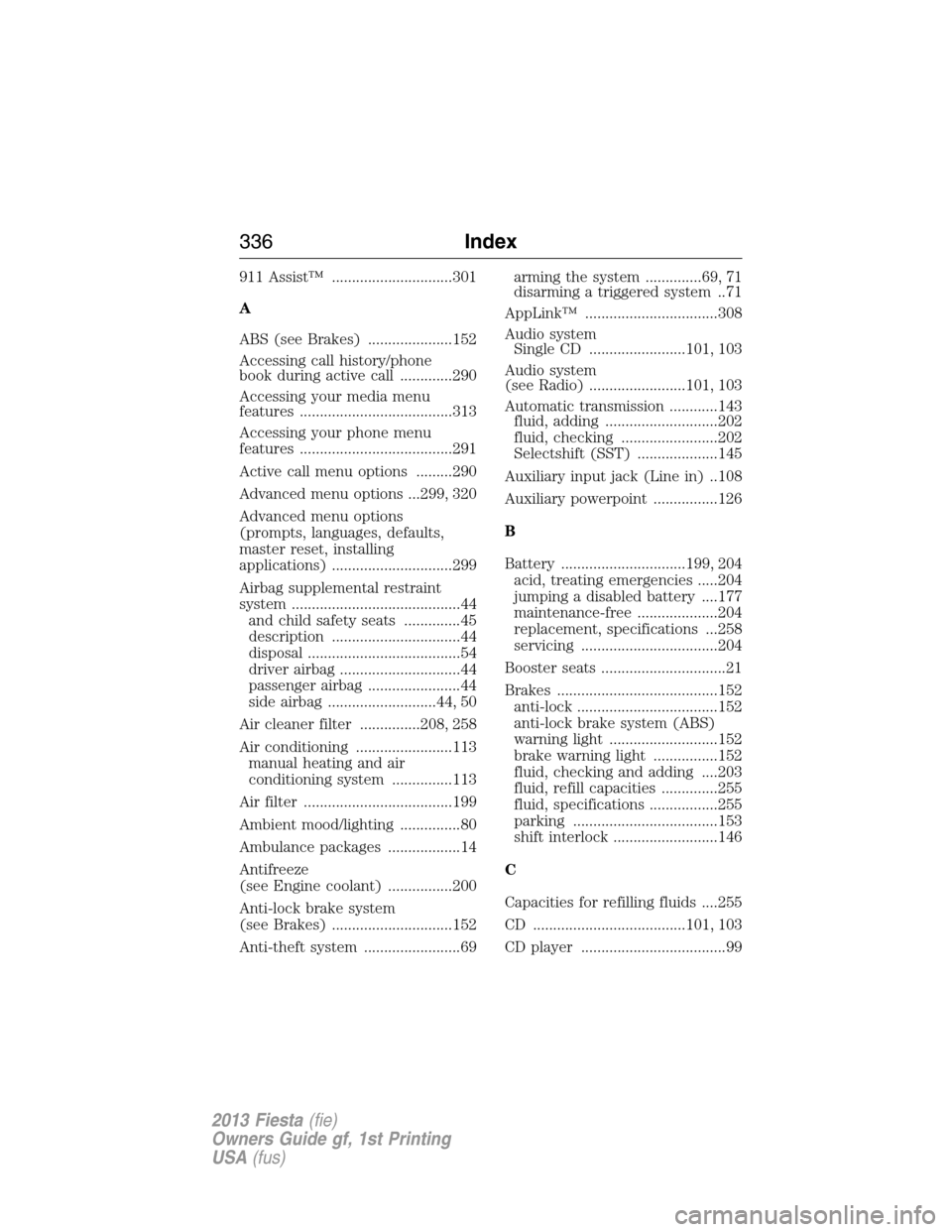
911 Assist™ ..............................301
A
ABS (see Brakes) .....................152
Accessing call history/phone
book during active call .............290
Accessing your media menu
features ......................................313
Accessing your phone menu
features ......................................291
Active call menu options .........290
Advanced menu options ...299, 320
Advanced menu options
(prompts, languages, defaults,
master reset, installing
applications) ..............................299
Airbag supplemental restraint
system ..........................................44
and child safety seats ..............45
description ................................44
disposal ......................................54
driver airbag ..............................44
passenger airbag .......................44
side airbag ...........................44, 50
Air cleaner filter ...............208, 258
Air conditioning ........................113
manual heating and air
conditioning system ...............113
Air filter .....................................199
Ambient mood/lighting ...............80
Ambulance packages ..................14
Antifreeze
(see Engine coolant) ................200
Anti-lock brake system
(see Brakes) ..............................152
Anti-theft system ........................69arming the system ..............69, 71
disarming a triggered system ..71
AppLink™ .................................308
Audio system
Single CD ........................101, 103
Audio system
(see Radio) ........................101, 103
Automatic transmission ............143
fluid, adding ............................202
fluid, checking ........................202
Selectshift (SST) ....................145
Auxiliary input jack (Line in) ..108
Auxiliary powerpoint ................126
B
Battery ...............................199, 204
acid, treating emergencies .....204
jumping a disabled battery ....177
maintenance-free ....................204
replacement, specifications ...258
servicing ..................................204
Booster seats ...............................21
Brakes ........................................152
anti-lock ...................................152
anti-lock brake system (ABS)
warning light ...........................152
brake warning light ................152
fluid, checking and adding ....203
fluid, refill capacities ..............255
fluid, specifications .................255
parking ....................................153
shift interlock ..........................146
C
Capacities for refilling fluids ....255
CD ......................................101, 103
CD player ....................................99
336Index
2013 Fiesta(fie)
Owners Guide gf, 1st Printing
USA(fus)